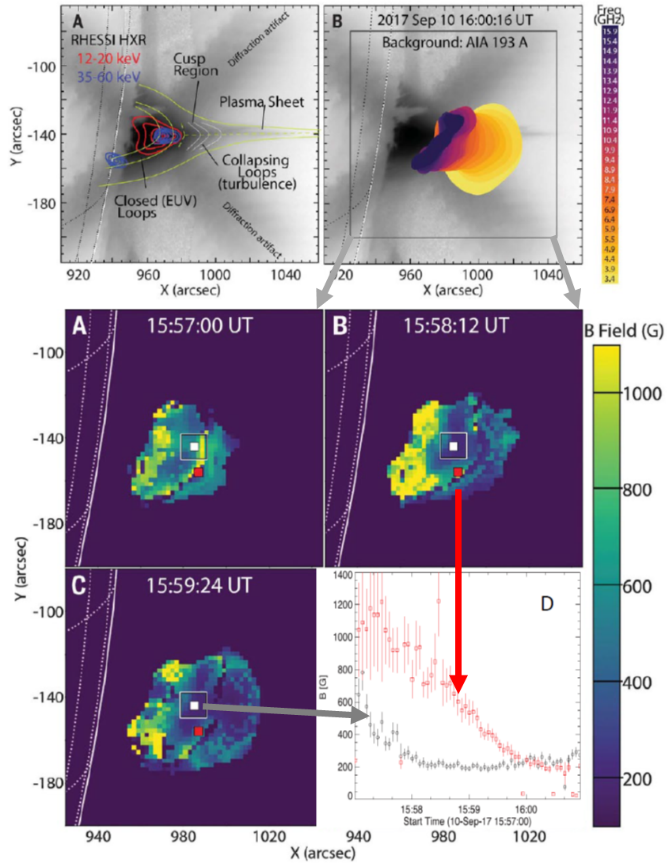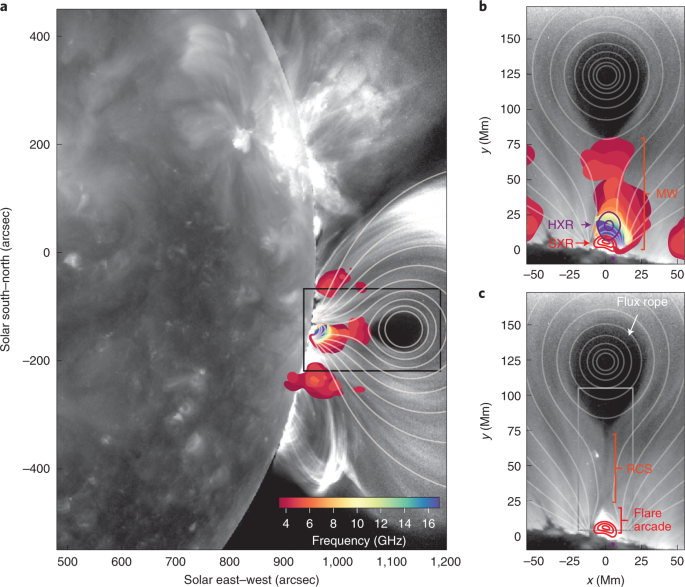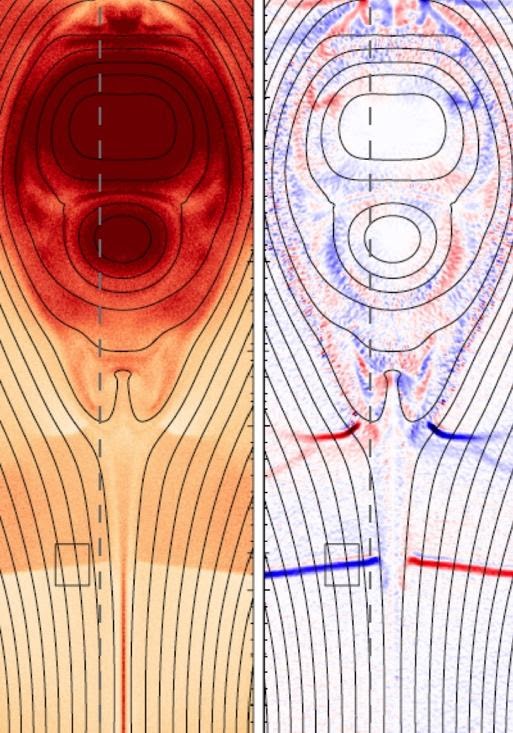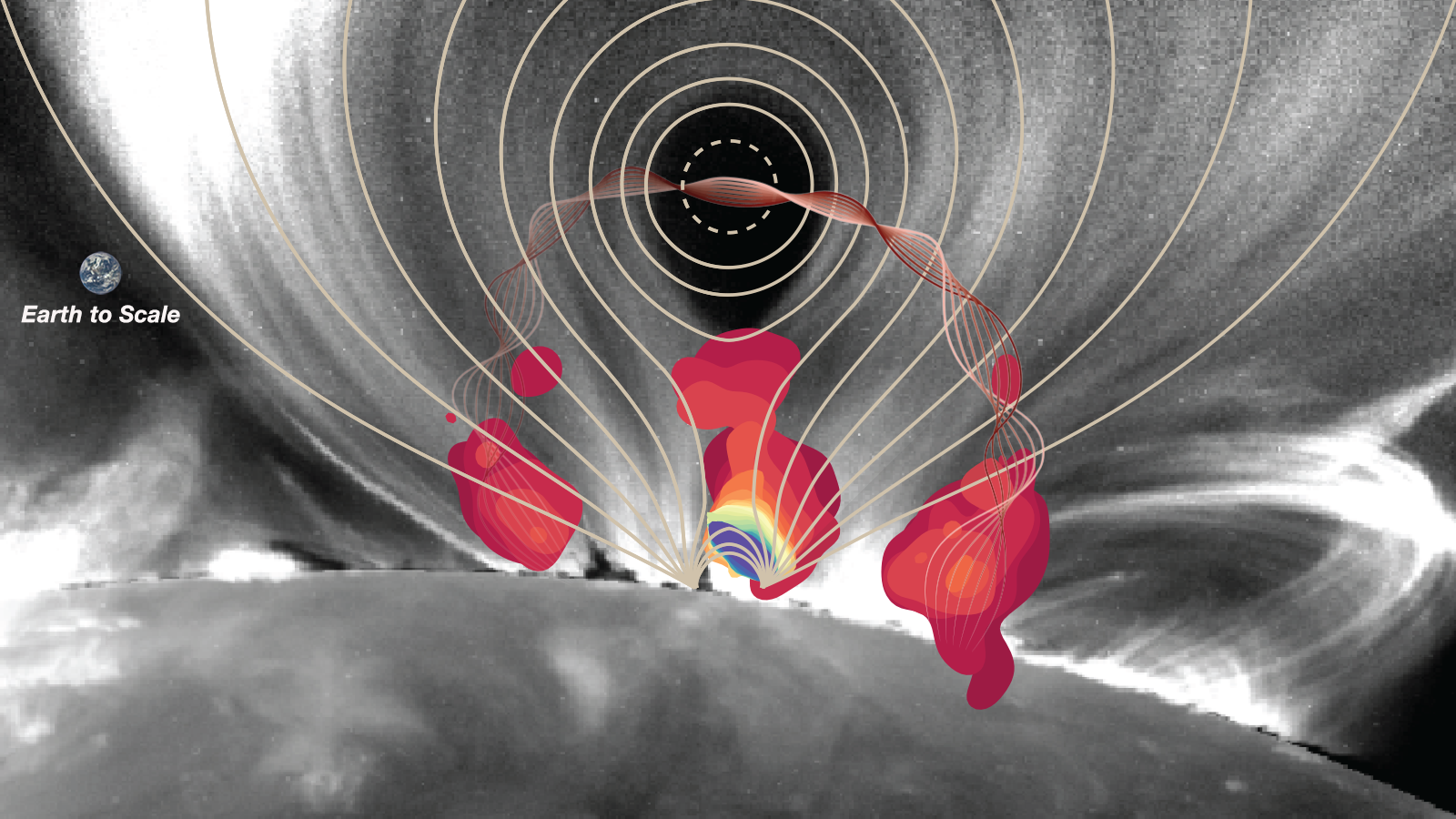 Top: multiwavelength observations including the EOVSA microwave data of the 2017-Sep-10 flare with an outline of morphological ingredients of the solar flare.<br />Bottom: three snapshots of evolving magnetic field maps (A-C) and two examples of decaying magnetic field (D) at two locations indicated in panels A-C as red and white squares. Solar flares are powered by a rapid release of magnetic energy in the solar corona. When, where, how, and with what rate the magnetic reconnection takes place to drive the solar flare remain biggest unknowns despite decades of intensive observational and theoretical studies. Direct quantitative measurements of the evolving magnetic field strength are required to clarify these questions, but such measurements have been lacking. Only most recently, with the novel methodology of microwave imaging spectroscopy, the first ever detailed spatially resolved measurements of evolving magnetic field and directly accelerated nonthermal electron population have been performed in a solar flare. They both confirmed some facets of a standard picture of solar flares and revealed entirely new, apparently unexpected features. With a new study published in Science, Dr. Gregory Fleishman of the New Jersey Institute of Technology (NJIT) and his colleagues used multi-frequency microwave imaging observations, provided by the Expanded Owens Valley Solar Array (EOVSA; a 13-element antenna array operated by NJIT), to obtain measurements of the evolving magnetic field in the flare cusp region (Figure 1) of a solar flare, showing spatial and temporal changes in the coronal magnetic field. The field decays at a rate of ~5 Gauss per second for 2 minutes, as measured within a flare subvolume of ~1028 cubic centimeters. This fast rate of decay implies a sufficiently strong electric field to account for the particle acceleration that produces the microwave emission. The decrease in stored magnetic energy is enough to power the solar flare, including the associated eruption, particle acceleration, and plasma heating.
Top: multiwavelength observations including the EOVSA microwave data of the 2017-Sep-10 flare with an outline of morphological ingredients of the solar flare.<br />Bottom: three snapshots of evolving magnetic field maps (A-C) and two examples of decaying magnetic field (D) at two locations indicated in panels A-C as red and white squares. Solar flares are powered by a rapid release of magnetic energy in the solar corona. When, where, how, and with what rate the magnetic reconnection takes place to drive the solar flare remain biggest unknowns despite decades of intensive observational and theoretical studies. Direct quantitative measurements of the evolving magnetic field strength are required to clarify these questions, but such measurements have been lacking. Only most recently, with the novel methodology of microwave imaging spectroscopy, the first ever detailed spatially resolved measurements of evolving magnetic field and directly accelerated nonthermal electron population have been performed in a solar flare. They both confirmed some facets of a standard picture of solar flares and revealed entirely new, apparently unexpected features. With a new study published in Science, Dr. Gregory Fleishman of the New Jersey Institute of Technology (NJIT) and his colleagues used multi-frequency microwave imaging observations, provided by the Expanded Owens Valley Solar Array (EOVSA; a 13-element antenna array operated by NJIT), to obtain measurements of the evolving magnetic field in the flare cusp region (Figure 1) of a solar flare, showing spatial and temporal changes in the coronal magnetic field. The field decays at a rate of ~5 Gauss per second for 2 minutes, as measured within a flare subvolume of ~1028 cubic centimeters. This fast rate of decay implies a sufficiently strong electric field to account for the particle acceleration that produces the microwave emission. The decrease in stored magnetic energy is enough to power the solar flare, including the associated eruption, particle acceleration, and plasma heating.
The need for a non-classical, fast release of the magnetic energy to drive the solar flare was recognized in early 1960s as the classical (Spitzer) dissipation of the magnetic energy is orders of magnitudes slower than observed in flares. Most of available models including PIC simulations favor the characteristic reconnection time τrec to be about τrec ~ 10 L/vA, where L is the characteristic scale of the system, vA is the Alfven speed. A strong disconnect between this modeling and the observations is that neither L nor vA can be measured at the flare energy release site. Moreover, even the very location where the main energy release takes place has not been known from observations because of the lack of reliable coronal probing. The ability to make the needed coronal measurements has appeared only recently due to the microwave imaging spectroscopy technique. The initial study published in this Science paper revealed that the main flare energy release takes place in the cusp region (Figure 1) rather than in the X-point as implied by the standard solar flare model. This finding needs to be evaluated in many more well-observed events.
Reference
“Decay of the coronal magnetic field can release sufficient energy to power a solar flare”, by Gregory D. Fleishman, Dale E. Gary, Bin Chen, Natsuha Kuroda, Sijie Yu, and Gelu M. Nita, Science, 2020. https://science.sciencemag.org/content/367/6475/278/tab-pdf
 This image, taken from a recent paper written by SolFER members, shows observations and modelling of an eruptive solar flare from September 10, 2017. The grant of computer time will allow SolFER members to understand better the energetic particles produced by this and other similar eruptions. Members of the SolFER collaboration have been awarded a substantial grant of computer time on the world-class Frontera supercomputer through the Large-Scale Community Partnerships program run by the University of Texas at Austin.
This image, taken from a recent paper written by SolFER members, shows observations and modelling of an eruptive solar flare from September 10, 2017. The grant of computer time will allow SolFER members to understand better the energetic particles produced by this and other similar eruptions. Members of the SolFER collaboration have been awarded a substantial grant of computer time on the world-class Frontera supercomputer through the Large-Scale Community Partnerships program run by the University of Texas at Austin.
 Two images from a simulation, similar to those to be performed on Frontera, that examined the production of energetic particles during solar flares. The left panel shows the plasma density and the right the component of the electric field parallel to the local magnetic field. Magnetic field lines are overplotted in black in both panels.SolFER (Solar Flare Energy Release) is a multi-institution collaboration funded by NASA’s DRIVE program to study the explosive release of magnetic energy in solar flares and the associated production of energetic particles. It brings together 12 institutions and more than 50 researchers with expertise in observations, theory, numerical modeling, and computer science. Figure 1 shows an example of the solar flares that SolFER will explore. Figure 2 shows an example of the type of simulation that will be performed on Frontera to model these flares and the associated production of energetic particles.
Two images from a simulation, similar to those to be performed on Frontera, that examined the production of energetic particles during solar flares. The left panel shows the plasma density and the right the component of the electric field parallel to the local magnetic field. Magnetic field lines are overplotted in black in both panels.SolFER (Solar Flare Energy Release) is a multi-institution collaboration funded by NASA’s DRIVE program to study the explosive release of magnetic energy in solar flares and the associated production of energetic particles. It brings together 12 institutions and more than 50 researchers with expertise in observations, theory, numerical modeling, and computer science. Figure 1 shows an example of the solar flares that SolFER will explore. Figure 2 shows an example of the type of simulation that will be performed on Frontera to model these flares and the associated production of energetic particles.
The Frontera supercomputer at the Texas Advanced Computing Center (TACC) currently ranks ninth on the twice-annual Top500 list, which ranks the world’s most powerful non-distributed computer systems. Located at The University of Texas at Austin, the National Science Foundation (NSF)-supported Frontera is the fastest university supercomputer in the world. To match what Frontera can compute in just one second, a person would have to perform one calculation every second for about a billion years.
The proposal team includes members from two universities, a Department of Energy national laboratory, and a NASA science laboratory. The Principal Investigator, Bill Daughton, works at the Los Alamos National Laboratory. Other members of the team include Spiro Antiochos (Goddard Space Flight Center), Harry Arnold (University of Maryland), Joel Dahlin (Goddard), Rick DeVore (Goddard), Jim Drake (Maryland), Marc Swisdak (Maryland), Fan Guo (Los Alamos), Xiaocan Li (Dartmouth College), and Qile Zhang (Los Alamos).
 Observation of a large solar flare in extreme ultraviolet (grayscale background) and multi-frequency microwaves (red to blue color). The microwave sources, observed by the Expanded Owens Valley Solar Array, provide crucial measurements for the “central engine” that powers the solar flare. Credit: NJIT-CSTR, B. Chen, S. Yu; NASA Solar Dynamics Observatory
Observation of a large solar flare in extreme ultraviolet (grayscale background) and multi-frequency microwaves (red to blue color). The microwave sources, observed by the Expanded Owens Valley Solar Array, provide crucial measurements for the “central engine” that powers the solar flare. Credit: NJIT-CSTR, B. Chen, S. Yu; NASA Solar Dynamics Observatory
A long and thin, “sheet”-like structure with a strong electric current—referred to as a “current sheet”—is believed to be the “central engine” that drives large eruptive solar flares. At the current sheet, opposing magnetic field lines approach, break, and reconnect. Consequently, the previously stored magnetic energy is released to power the eruption (often observed as a coronal mass ejection) and to produce flare emissions observable in virtually the entire electromagnetic spectrum from radio to X-rays. The released magnetic energy is also responsible for accelerating charged particles to nearly the speed of light.
Solar astronomers have been able to infer the presence of such current sheets in solar flares. However, there has been heretofore no measurement of its magnetic properties. With this new study published in Nature Astronomy, Prof. Bin Chen of the New Jersey Institute of Technology (NJIT) and his colleagues used multi-frequency microwave imaging observations, provided by the Expanded Owens Valley Solar Array (EOVSA; a 13-element antenna array operated by NJIT), to obtain measurements of the magnetic field of a current sheet in a large eruptive solar flare for the first time. Remarkably, the measured magnetic field matches closely with predictions in a well-known analytical model of the “standard” solar flare scenario as well as numerical simulations based on magnetohydrodynamics equations.
The measurements also reveal a magnetic, bottle-like structure—referred to as a “magnetic bottle”—located near the bottom of the current sheet and above the newly formed flare arcade (via magnetic reconnection). The study shows that, while a huge amount of magnetic energy is being pumped into the main body of the current sheet at an estimated rate of 10-100 billion trillion joules per second, 99% of the observed relativistic electrons concentrate at the bottom of the current sheet near the magnetic bottle.
This study suggests that, at least in the present event, the magnetic bottle appears to be crucial in producing or confining the relativistic electrons. These observations will inspire further observational, theoretical, and modeling studies on solar flare energy release and particle acceleration, which is main science topic of the SolFER collaboration.
*The study is supported partly by the NASA Heliophysics DRIVE Center grant #80NSSC20K0627 to NJIT.
Reference
“Measurement of magnetic field and relativistic electrons along a solar flare current sheet”, by Bin Chen, Chengcai Shen, Dale E. Gary, Katharine K. Reeves, Gregory D. Fleishman, Sijie Yu, Fan Guo, Säm Krucker, Jun Lin, Gelu Nita, Xiangliang Kong, Nature Astronomy, 2020. https://www.nature.com/articles/s41550-020-1147-7
